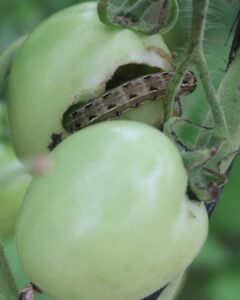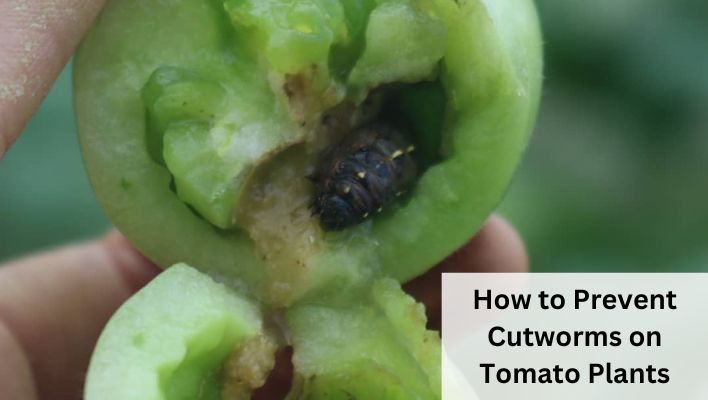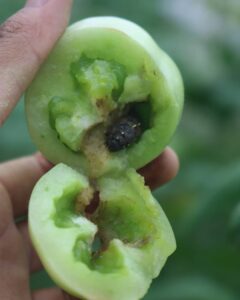When it comes to growing beautiful, juicy tomatoes, there’s nothing more frustrating than discovering cutworm damage on your precious plants. These sneaky pests have a knack for wreaking havoc on tomato and vegetable gardens, causing stem girdling and even plant death.
But with the right knowledge and preventive measures, you can keep cutworms at bay and enjoy a thriving tomato harvest.
In this comprehensive guide, we’ll delve into the world of cutworms and explore effective strategies to prevent their infestations on tomato plants.
We’ll cover everything from understanding the behavior of these destructive pests to implementing organic and cultural methods of control.
Cutworms are caterpillars that belong to the Noctuidae family, and they can pose a significant threat to your tomato plants. These voracious feeders emerge in the spring and can remain active throughout the growing season, causing extensive damage along the way.
They have a particular affinity for tender tomato seedlings, which makes prevention all the more crucial. Preventing cutworm damage is not only about safeguarding the aesthetics of your garden but also ensuring a bountiful harvest.
By implementing preventive measures, you can protect the stems of your tomato plants, allowing them to grow strong, produce abundant fruit, and reach their full potential. Below, we’ll explore a range of preventive measures to keep cutworms at bay.
Signs of Cutworm Infestation on tomato plants
Identifying a cutworm infestation early on is crucial for effective intervention. These cunning pests often operate under cover of darkness, leaving behind subtle clues during their feeding frenzy.
Here are some signs to look out for that may indicate a cutworm infestation on your tomato plants:

- Missing Seedlings: Cutworms have a knack for targeting young, tender tomato seedlings. If you notice that some of your seedlings have mysteriously disappeared overnight, with no trace of leaves or stems, cutworms could be the culprits. They sever the plants at the base, leaving behind nothing but a sad, wilted stump.
- Cut Stems: Another telltale sign of cutworm damage is finding tomato stems that have been neatly severed near the soil line. Cutworms typically feed at ground level, and their sharp mandibles make quick work of slicing through the stems. If you come across severed stems, examine the area closely for other signs of cutworm activity.
- Visible Larvae: Cutworms are nocturnal creatures, hiding in the soil during the day and emerging at night to feast on your tomato plants. If you venture into your garden after dark with a flashlight, you may spot these plump, grayish-brown caterpillar-like larvae crawling near the affected plants. They are usually about an inch or two long, with a smooth body and a slight curl when at rest.
- Tunneling in the Soil: In some cases, cutworms may leave evidence of their presence in the form of tunnels or burrows in the soil near the base of tomato plants. These tunnels serve as hiding spots during the day and pathways for the cutworms to access their food source at night. Carefully examine the soil around your tomato plants for any signs of disturbance or small tunnels.
- Damaged Foliage: Although cutworms primarily target the stems of young seedlings, they may also munch on the foliage of more mature tomato plants. If you notice irregular holes or ragged edges on the leaves, it could be a sign of cutworm feeding activity.
By familiarizing yourself with these signs, you’ll be able to take prompt action and protect your tomato plants from further damage. Here is a detailed guide to getting rid of cutworms naturally.
How to Prevent Cutworms on Tomato Plants
Preventing cutworm infestations is essential for the health and productivity of your tomato plants. Fortunately, there are several effective methods you can employ to keep these pesky pests at bay. Let’s explore some preventive measures and strategies:
Creating a Cutworm Barrier:
- Physical Barriers: Surrounding your tomato plants with physical barriers can be highly effective in deterring cutworms. Use materials such as cardboard collars, toilet paper rolls, or plastic cups with the bottom cut out. Place these barriers around the base of each plant, pushing them about an inch into the soil. This prevents cutworms from reaching the stems.
- Collars and Protective Sleeves: Another option is to create protective collars using cardboard or aluminum foil. Make collars that are about 3 inches tall and encircle the base of the tomato plant. This makes it difficult for cutworms to access the stems.
- Mulching: Applying a layer of organic mulch, such as straw or wood chips, around your tomato plants acts as a barrier against cutworms. The mulch creates a physical obstacle and makes it harder for cutworms to crawl toward the plants.
Natural Predators and Beneficial Insects:
- Encouraging Beneficial Insects: Attracting beneficial insects to your garden can help control cutworm populations naturally. Plant flowers that provide nectar and pollen to beneficial insects, such as ladybugs, lacewings, and parasitic wasps. These predators feed on cutworm eggs and larvae, keeping their numbers in check.
- Birds as Natural Cutworm Predators: Attracting birds to your garden can be an effective way to combat cutworms. Install bird feeders, bird baths, or provide nesting boxes to encourage bird activity. Birds, like robins and sparrows, feed on cutworms and other garden pests.
Companion Planting Strategies:
- Plants that Deter Cutworms: Certain plants act as natural repellents to cutworms. Consider interplanting your tomato plants with companion plants such as marigolds, calendula, or garlic. These plants emit odors that repel cutworms and other pests.
- Attracting Beneficial Insects: Companion planting can also attract beneficial insects that prey on cutworms. Plants like dill, fennel, and yarrow attract beneficial insects like hoverflies and parasitic wasps, which are natural enemies of cutworms.
Cultural Practices:
- Timing and Spacing: Plant your tomato seedlings at the appropriate time, when the soil has warmed up and the risk of cutworms is reduced. Proper spacing between plants also helps to limit the spread of cutworm infestations.
- Removing Garden Debris and Weeds: Cutworms often hide in garden debris and weeds during the day. Regularly clean up fallen leaves, plant debris, and weeds near your tomato plants to eliminate potential hiding spots for these pests.
- Crop Rotation and Diversity: Rotate your tomato plants to different areas of your garden each year. Cutworms tend to lay their eggs near the base of previously infested plants, so rotating crops helps break their life cycle. Additionally, growing a diverse range of plants in your garden reduces the attractiveness of a single food source for cutworms.
Organic Solutions:
- Homemade Organic Sprays and Deterrents: Create organic sprays using ingredients like garlic, hot peppers, or neem oil. These can be sprayed directly on tomato plants to deter cutworms. Additionally, diatomaceous earth, a natural abrasive substance, can be sprinkled around the base of plants to create a barrier that irritates and repels cutworms.
- Beneficial Nematodes: Beneficial nematodes are microscopic organisms that prey on cutworm larvae in the soil. These can be purchased and applied to the soil around tomato plants according to the instructions on the packaging.
Handpicking:
One of the simplest and most effective methods is to physically remove cutworms from your tomato plants. Inspect your plants regularly, especially during the evening or early morning when cutworms are more active. Wear gloves and pick off the cutworms you find, dropping them into a bucket of soapy water to ensure they won’t return.
Trenching:
Create a protective trench around the base of your tomato plants to deter cutworms. Dig a shallow trench about 2 inches deep and 2 inches wide around the plant, exposing the soil. Cutworms will encounter the trench when trying to access the plant, making it more difficult for them to reach the stems.
Floating Row Covers:
Covering your tomato plants with a lightweight, breathable fabric known as floating row covers can act as a physical barrier against cutworms. The covers allow sunlight and rain to reach the plants while keeping cutworms and other pests at bay. Secure the edges of the covers to the ground to prevent any gaps.
Solarization:
Solarization is a technique that utilizes the sun’s heat to kill cutworms and other soil-dwelling pests. Before planting your tomatoes, moisten the soil and cover it with a clear plastic sheet, sealing the edges. Leave the plastic in place for several weeks during the hottest months of the year. The heat trapped under the plastic will effectively kill cutworms and their eggs.
Introduce Beneficial Nematodes:
Beneficial nematodes are microscopic organisms that naturally occur in the soil and feed on cutworm larvae. You can purchase nematodes from garden centers or online stores and apply them to the soil around your tomato plants according to the package instructions.
Monitoring and Early Intervention:
Regular monitoring of your tomato plants is vital in catching cutworm infestations early. Keep an eye out for any signs of cutworm activity, such as chewed leaves or stems. If you spot cutworms, take immediate action using the methods mentioned above to prevent the infestation from spreading.
Chemical pesticides to get rid of cutworms
When it comes to dealing with cutworms on tomato plants, here are three effective chemical pesticide brands that can help control the infestation:
Sevin GardenTech Ready to Spray Insect Killer:
Sevin is a widely recognized brand that offers effective control against cutworms and other garden pests. The active ingredient in Sevin is carbaryl, which acts as a broad-spectrum insecticide. It works by disrupting the nervous system of cutworms, leading to their elimination.
To use Sevin, follow the instructions on the product label for proper dilution and application. Apply the pesticide to the soil around the base of the tomato plants, targeting the area where the cutworms are active.

Take care to avoid direct contact with the foliage or edible parts of the plant. Repeat the application as needed, usually at specified intervals mentioned on the label.
Bonide Caterpillar and Worm Killer:
Bonide Caterpillar and Worm Killer is another effective brand for controlling cutworms on tomato plants. The active ingredient in this pesticide is spinosad, derived from naturally occurring soil bacteria. Spinosad affects the nervous system of the cutworms, ultimately leading to their demise.

Mix the specified amount of Bonide Caterpillar and Worm Killer with water, following the instructions on the label. Thoroughly spray the tomato plants, targeting the lower stems and the surrounding soil.
Repeat the application as necessary, typically at specified intervals mentioned on the label or as the infestation persists.
How to Prevent Cutworms on Tomato Plants FAQs
Are cutworms only active at night?
Yes, cutworms are predominantly nocturnal pests. They are most active during the night and tend to hide in the soil during the day.
This behavior makes it challenging to spot them directly on the plants during daylight hours. Cutworms emerge from the soil at night to feed on the stems of plants, including tomato plants.
Their nocturnal activity is why it’s recommended to inspect your garden in the evening or early morning when they are more likely to be active.
Can cutworms kill tomato plants?
Cutworms can indeed cause significant damage to tomato plants, and in severe infestations, they can even kill young seedlings or severely hinder the growth of more established plants.
Cutworms feed on the stems of tomato plants near the soil line, often severing them completely.
This disrupts the flow of nutrients and water to the rest of the plant, causing wilting and eventually leading to the plant’s demise. It’s crucial to take preventive measures to protect your tomato plants from cutworm damage.
When is the best time to implement preventive measures?
It’s advisable to implement preventive measures before cutworms become a problem in your garden. The best time to start implementing preventive strategies is when you are preparing your garden for planting.
This includes clearing away any garden debris, weeds, or other potential hiding places for cutworms. You can also create physical barriers, such as collars or protective sleeves, around the base of your tomato plants.
By being proactive and implementing preventive measures early on, you can significantly reduce the risk of cutworm damage.
How do collars protect tomato plants from cutworms?
Collars provide an effective means of protecting tomato plants from cutworms. These collars act as physical barriers that prevent the cutworms from reaching the stems of the plants.
Collars are typically made from materials like cardboard, aluminum foil, or plastic. They are placed around the base of each plant, extending a few inches above the soil surface.
The collar creates a barrier that cutworms find difficult to crawl over, effectively preventing them from reaching and damaging the stems of the tomato plants.
Collars are a simple yet highly effective method of safeguarding your tomato plants from cutworm infestations.
Conclusion
You’ve now equipped yourself with a comprehensive set of strategies to prevent cutworms from wreaking havoc on your precious tomato plants.
By implementing these preventive measures, you’ll significantly reduce the risk of cutworm infestations and ensure the health and productivity of your garden.
Remember, the early detection of cutworm signs, such as missing seedlings, cut stems, visible larvae, tunneling in the soil, or damaged foliage, is crucial for effective intervention.
By staying vigilant and promptly addressing any signs of cutworm activity, you can nip the problem in the bud and save your tomato plants from further damage.
By integrating these preventive measures, cultural practices, organic solutions, and, if necessary, chemical control options, you’re well-prepared to protect your tomato plants from cutworm damage and ensure a thriving harvest.

